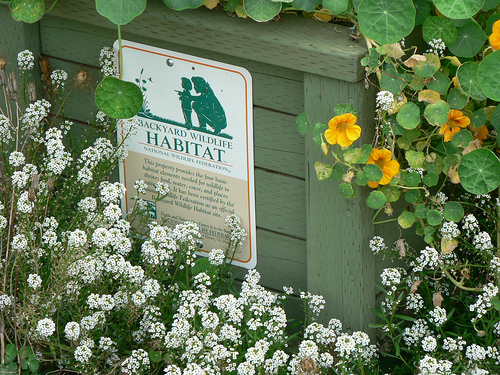We recently planted some new shrubs and plants in our yard, and it was just last week I felt that we chose some of the right vegetation when my wife called me outside to see the butterfly that had landed on our butterfly bush for a short break. While most folks on the Hill don’t have a huge yard or acres of land to cultivate (or probably enough time to tend to it), many of us have some green space that we try to look after and keep looking presentable. You may use your yard for growing veggies or grilling, but you aren’t the only beings that need that green space, especially in a dense urban area. In neighborhoods like Capitol Hill, our yards and gardens can attract all sorts of creatures — welcome and not — and how you plant and furnish your outdoor space can influence who you attract.
The Certified Wildlife Habitat program is offered by the National Wildlife Federation as a way to help homeowners arrange their yards to benefit local wildlife. It doesn’t matter how large or small your yard is. Taking a few simple steps can ensure birds, butterflies, and other indigenous creatures have a place to live.
There are five core concepts that need to be included in order to certify a yard, terrace, or balcony as a habitat in the program. Food, water, and shelter need to be provided. Places to raise young must be available, and the gardening must be done in an environmentally-sensitive way. Food for native species can come from berries, seeds, fruits, or nuts from planted trees and shrubs or from feeders placed in the space. At least three food options are required. One source of water is required, which can be a natural body of water (obviously not likely on the Hill) or a birdbath. NWF recommends water changes two or three times a week in the birdbath to prevent mosquitoes. Shelter can occur in many forms, including native vegetation, roosting boxes, rock piles, or ground cover. Select your shelter carefully so as not to provide cover for unwanted critters — you may want to forego ground cover plantings if you are concerned about rats and mice and instead consider trees or manmade boxes for bats and birds. Most of these shelter options can also count toward the two required locations for species to raise their young. Nesting boxes work well for birds, and certain shrubs are favored by butterflies to host caterpillars.
The last requirement is to follow at least two sustainable practices in your garden or yard. The NWF accepts many options for this requirement, including mulching around planting beds to preserve moisture, capturing rainwater for reuse, limiting pesticides, removing non-native plants, composting, or installing water-conserving irrigation systems. If you are considering redoing your yard, you can also consider xeriscaping, which is the practice of selecting native, drought-tolerant plants that would not require artificial irrigation.
The certification through the Certified Wildlife Habitat program costs $20, but in return you get a certificate, a year’s subscription to the NWF magazine and quarterly newsletter, and recognition in the national registry of certified wildlife habitats. An optional yard sign can also be purchased to make your neighbors jealous and advertise to migrating birds. If you have some changes or additions to make to your yard to qualify as a certified habitat, consider making it a family project and get the kids involved for an early lesson in conservation, then spend some time looking for the wildlife you hope to attract.


Great post! I had no idea this program existed, but I’m now 100% on board. Do you happen to know of any local nurseries specializing in native plants? Or even a list of plants native to our area? Thanks!
I don’t know of a nursery specializing in native plants, but Frager’s or Ginkgo Gardens would at least be able to point you in the right direction. Casey Trees maintains a list of native tree species appropriate from this region.
this is a little off-topic, but my veggies seem to die right after their buds come out – a little yellow flower from a tomato becomes crusty brown, and no tomato appears. Is this because it’s not being pollinated? If so, how do I attract pollenators?!?